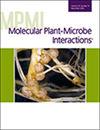求助PDF
{"title":"光合作用对植物病原体感染的反应","authors":"Alissar Cheaib, Nabil Killiny","doi":"10.1094/MPMI-05-24-0052-CR","DOIUrl":null,"url":null,"abstract":"<p><p>Photosynthesis, the remarkable process by which green plants synthesize nutrients using light energy, plays a crucial role in sustaining life on Earth. However, the effects of pathogens on photosynthesis are not widely understood. In general, a reduction of photosynthesis occurs upon the infection with pathogens. Two main scenarios are responsible for the reduction in photosynthetic capacity. In the first scenario, the pathogen attacks green aerial tissues, such as when caused by fungal and bacterial leaf spots and blights, which affect photosynthesis by destroying green leaf tissue or causing defoliation. This leads to a decrease in the photosynthetic area, ultimately reducing photosynthesis. Interestingly, even when the overall chlorophyll content of leaves is significantly reduced due to pathogen invasion, the remaining chlorophyll-containing leaf area may maintain or even enhance its photosynthetic efficiency. This compensatory mechanism helps mitigate the loss of photosynthetic area. However, the overall yield of the plant is still affected. The second scenario is a reduction in chlorophyll content due to chlorosis, which is characterized by yellowing of leaves. It is a common symptom of plant diseases. It refers to a reduction in the amount of chlorophyll per chloroplast rather than a decrease in chloroplast number. Diseases caused by viruses and phytoplasmas often exhibit chlorosis. While pathogens disrupt photosynthesis, plants exhibit significant adaptations to cope with these challenges. Understanding these interactions is essential for sustainable agriculture and ecosystem health. Thus, in this review, we discuss the effect of several pathogens on the photosynthesis processes and efficiency in detail. [Formula: see text] Copyright © 2025 The Author(s). This is an open access article distributed under the CC BY-NC-ND 4.0 International license.</p>","PeriodicalId":19009,"journal":{"name":"Molecular Plant-microbe Interactions","volume":" ","pages":"9-29"},"PeriodicalIF":3.4000,"publicationDate":"2025-02-01","publicationTypes":"Journal Article","fieldsOfStudy":null,"isOpenAccess":false,"openAccessPdf":"","citationCount":"0","resultStr":"{\"title\":\"Photosynthesis Responses to the Infection with Plant Pathogens.\",\"authors\":\"Alissar Cheaib, Nabil Killiny\",\"doi\":\"10.1094/MPMI-05-24-0052-CR\",\"DOIUrl\":null,\"url\":null,\"abstract\":\"<p><p>Photosynthesis, the remarkable process by which green plants synthesize nutrients using light energy, plays a crucial role in sustaining life on Earth. However, the effects of pathogens on photosynthesis are not widely understood. In general, a reduction of photosynthesis occurs upon the infection with pathogens. Two main scenarios are responsible for the reduction in photosynthetic capacity. In the first scenario, the pathogen attacks green aerial tissues, such as when caused by fungal and bacterial leaf spots and blights, which affect photosynthesis by destroying green leaf tissue or causing defoliation. This leads to a decrease in the photosynthetic area, ultimately reducing photosynthesis. Interestingly, even when the overall chlorophyll content of leaves is significantly reduced due to pathogen invasion, the remaining chlorophyll-containing leaf area may maintain or even enhance its photosynthetic efficiency. This compensatory mechanism helps mitigate the loss of photosynthetic area. However, the overall yield of the plant is still affected. The second scenario is a reduction in chlorophyll content due to chlorosis, which is characterized by yellowing of leaves. It is a common symptom of plant diseases. It refers to a reduction in the amount of chlorophyll per chloroplast rather than a decrease in chloroplast number. Diseases caused by viruses and phytoplasmas often exhibit chlorosis. While pathogens disrupt photosynthesis, plants exhibit significant adaptations to cope with these challenges. Understanding these interactions is essential for sustainable agriculture and ecosystem health. Thus, in this review, we discuss the effect of several pathogens on the photosynthesis processes and efficiency in detail. [Formula: see text] Copyright © 2025 The Author(s). This is an open access article distributed under the CC BY-NC-ND 4.0 International license.</p>\",\"PeriodicalId\":19009,\"journal\":{\"name\":\"Molecular Plant-microbe Interactions\",\"volume\":\" \",\"pages\":\"9-29\"},\"PeriodicalIF\":3.4000,\"publicationDate\":\"2025-02-01\",\"publicationTypes\":\"Journal Article\",\"fieldsOfStudy\":null,\"isOpenAccess\":false,\"openAccessPdf\":\"\",\"citationCount\":\"0\",\"resultStr\":null,\"platform\":\"Semanticscholar\",\"paperid\":null,\"PeriodicalName\":\"Molecular Plant-microbe Interactions\",\"FirstCategoryId\":\"99\",\"ListUrlMain\":\"https://doi.org/10.1094/MPMI-05-24-0052-CR\",\"RegionNum\":3,\"RegionCategory\":\"生物学\",\"ArticlePicture\":[],\"TitleCN\":null,\"AbstractTextCN\":null,\"PMCID\":null,\"EPubDate\":\"2025/2/25 0:00:00\",\"PubModel\":\"Epub\",\"JCR\":\"Q2\",\"JCRName\":\"BIOCHEMISTRY & MOLECULAR BIOLOGY\",\"Score\":null,\"Total\":0}","platform":"Semanticscholar","paperid":null,"PeriodicalName":"Molecular Plant-microbe Interactions","FirstCategoryId":"99","ListUrlMain":"https://doi.org/10.1094/MPMI-05-24-0052-CR","RegionNum":3,"RegionCategory":"生物学","ArticlePicture":[],"TitleCN":null,"AbstractTextCN":null,"PMCID":null,"EPubDate":"2025/2/25 0:00:00","PubModel":"Epub","JCR":"Q2","JCRName":"BIOCHEMISTRY & MOLECULAR BIOLOGY","Score":null,"Total":0}
引用次数: 0
引用
批量引用

 求助内容:
求助内容: 应助结果提醒方式:
应助结果提醒方式:


